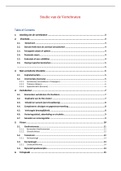Summary
Samenvatting Studie Van De Vertebraten
Dit is een samenvatting van alle dieren die te kennen zijn in het cladogram en heel de classificatie. De te kennen diersoorten zijn vetgedrukt en bij elke groep staan specifieke kenmerken. Dit is verduidelijkt met aantekeningen, tekeningen en foto's.
[Show more]
Preview 3 out of 23 pages
Uploaded on
August 9, 2022
Number of pages
23
Written in
2020/2021
Type
Summary
cladogram
vertebraten
anatomie
classificatie
Institution
Universiteit Gent (UGent)
Education
Diergeneeskunde
Course
Studie Van De Vertebraten En Algemene Anatomie Van De Huisdieren (G000718A)
All documents for this subject (24)
$11.24
100% satisfaction guarantee
Immediately available after payment
Both online and in PDF
No strings attached
Studie van de Vertebraten




